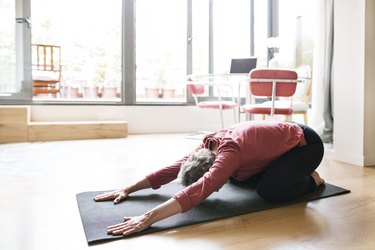

With coccydynia, aka tailbone pain, sitting is one of the most painful things you can do. Fortunately, (literally) getting off your rear and doing some tailbone pain exercises can help you feel better.
Exercises for tailbone pain work by both stretching and strengthening the muscles, tendons and ligaments surrounding the tailbone, or coccyx. Some tailbone exercises even strengthen the pelvic floor muscles, which connect to the tailbone. According to an August 2016 study published in PM&R, pelvic floor physical therapy can help ease coccydynia or tailbone pain.
Video of the Day
Stretching and doing exercises aimed at improving posture are especially helpful for reducing tailbone pain, per the Cleveland Clinic.
Demonstrated by Holly Perkins, CSCS, creator of The Glutes Project ACTIVATE are six tailbone pain stretches and exercises you can easily do at home to ditch that pain in the butt.
1. Cat-Cow
- Get on your hands and knees in tabletop position — hands directly under the shoulders and knees directly under your hips.
- Exhale and round your back up to the sky (cat).
- Inhale and arch your back with your head lifting up (cow).
- Repeat.
Tip
As you move through cat-cow, sync your motions with your breath. This move should feel like a tension release.
2. Glute Bridge
- Lie on your back. Your knees should be bent and the bottoms of your feet should be touching the floor. Keep your arms resting alongside your body.
- Slowly lift your torso upward, starting at your hips.
- Continue to lift your hips while pushing your heels into the ground.
- Hold this position, then slowly lower your hips back to the starting position.
Related Reading
3. Child's Pose
- Get on your hands and knees in tabletop position — hands directly under the shoulders and knees directly under your hips.
- Sit your buttocks back onto your heels and lower your chest to the floor, keeping your hands fixed on the floor in front of you.
- Hold the stretch, breathing slowly.
4. Supine Spinal Twist
- Lie down on your back. Bring the left knee into the chest. Extend your right leg out on the floor.
- Lower your left knee across the right leg.
- For an added stretch, place your right hand on your left knee, gently pressing it downward.
- Look over your left shoulder. Keep your shoulders in contact with the floor.
- Hold the stretch.
Tip
The supine spinal twist can help release tension throughout your entire back, including your tailbone. Plus, it's a yoga move you can do right from your bed in the morning.
5. Cobra Pose
- Lie face down and place your elbows on the floor under your shoulders, with your hands forward.
- Stretch and lift your chest to the sky while extending the elbows and straightening the arms. Keep your hips in contact with the floor and squeeze your shoulder blades together.
- Breathe deeply as you hold this stretch.
- If you do not have the flexibility to straighten your arms, lift them as high as you can with your elbows bent.
6. Root Lock
- Sit down in a chair or on the floor.
- Tighten your pelvic muscles as if you're trying to lift a marble from under your seat or stop a urine stream.
- Hold for a few seconds, focusing on tightening only your pelvic floor muscles and breathing deeply.
- Slowly relax your muscles and repeat.
Common Tailbone Pain Causes — and How Tailbone Pain Exercise Can Help
According to the National Institutes of Health (NIH), injuries to the coccyx, or tailbone, are most commonly the result of backward falls onto a hard surface.
The coccyx is a tiny triangular bone made up of four bones at the very end of the spine, but fractures in it are rare. Falling onto the coccyx usually results in bruising of the bone. It can sometimes cause a partial or complete coccyx dislocation due to pulling of attached ligaments, according to the NIH.
Tailbone alignment exercises can help support rehabilitation from coccyx dislocation or coccyx subluxation (a partial dislocation). If you think you might have a dislocation, talk to your doctor for an examination.
Several factors contribute to chronic coccydynia, including malformation of the coccyx, bony spurs on the coccyx, muscle strain, pinched or damaged nerves, damage to ligaments from a difficult pregnancy, obesity or poor posture, according to the Cleveland Clinic.
While conventional medical treatment will help to alleviate the symptoms and underlying issues, tailbone pain exercises can help support the best recovery possible.
Related Reading
Was this article helpful?
150 Characters Max
0/150
Thank you for sharing!
Thank you for your feedback!